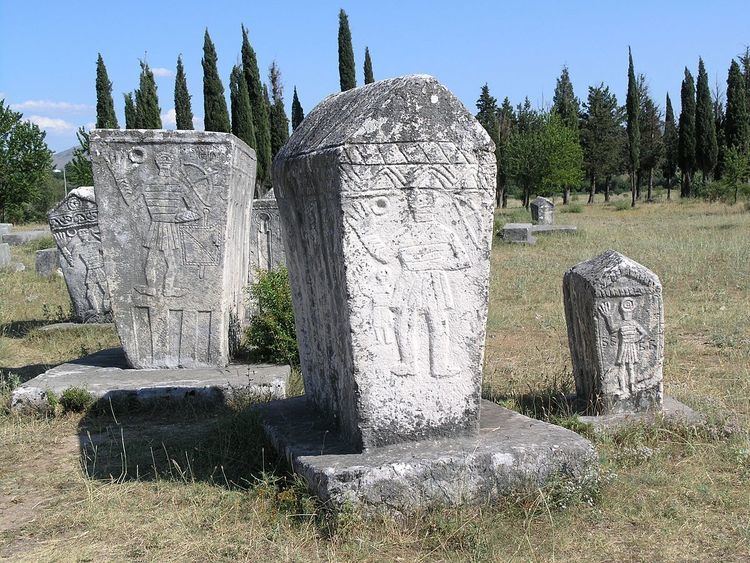Address Bosnia and Herzegovina | Phone +387 36 819-043 | |
 | ||
Hours Open today · 7AM–7PMThursday7AM–7PMFriday7AM–7PMSaturday9AM–6PMSundayClosedMonday7AM–7PMTuesday7AM–7PMWednesday7AM–7PMSuggest an edit Profiles | ||
Radimlja nekropola ste aka stolac
Radimlja is a stećak necropolis located near Stolac, Bosnia and Herzegovina. It is located in Vidovo polje, 3 km west of Stolac, on the Čapljina-Stolac road. The Radimlja necropolis is one of the most valuable monuments of the mediaeval period in Bosnia and Herzegovina.
Contents
- Radimlja nekropola ste aka stolac
- Bogumilska nekropola radimlja
- History
- Characteristics
- Decoration
- Inscriptions
- References
Bogumilska nekropola radimlja
History
The majority of its stećak tombstones date from the 1480s and 16th centuries, as evidenced by the epitaph on one of the tombstones - this was the period when the Vlach family Miloradović-Stjepanović from genus Hrabren lived in the settlement located on near hill Ošanići. At the time the location was known as Batnoge, and the period of creation of the necropolis coincides with social-economical rise of the Vlachs.
Miloradović-Stjepanović family from the genus Hrabren were of Orthodox faith. The founder was Milorad, who as a chieftain of Vlach origin lived in the second half of 14th century. In 1416 is mentioned his son, Stipan, in appeal by Ragusa due to fighting along Petar Pavlović against Sandalj Hranić and Ottomans. He had three sons: Petar Stjepanović is first mentioned in 1473 and last time in 1486, Radoja Stjepanović died between 1475-1477, while Vukić Stjepanović was mentioned for last time in 1496.
They were titled as voivodes and knezes, commanded Vlach military institution and held land between Stolac and Mostar. They successfully incorporated into the Ottoman political and social system. The katun formation by Petar and Vukić Hrabren was part of the Vlach group Donji Vlasi (Lower Vlachs) of nahiye Blagaj - and their katun was the largest with 127 houses and 16 unmarried persons out of 37 katuns, 1383 houses and 177 unmarried persons. At the time Petar Stjepanovič-Hrabren along knezes Vukac, Pavko, Stipan and Radivoj Popratović was included in the order of Ragucan citizens, as well was Ottoman timariot. By 1505, when was buried voivode Radosav Hrabren, the necropolis expansion began to end due to local Vlachs acceptance of Islam, disintegration of tribal organization, and wide social events.
Characteristics
Currently the necropolis numbers 133 stećci. When the Čapljina-Stolac road was built during the Austro-Hungarian period in 1882, it ran through the necropolis and destroyed at least 15-20 tombstones in the process. Out of nine type of stećci, there 36 slab, 1 slab with pedestal, 27 chest, 24 chest with pedestal, 4 tall chest, 5 tall chest with pedestal, 2 sarcophagus (i.e. ridge/gable), 31 sarcophagus with pedestal, and 3 of cruciform.
The core of the necropolis was built in the end of 14th century, when were made three big chests, of which two are richly decorated with motifs in bas relief. The next phase include simple chests (sanduk) and ridges (sljemenaci) with flower crosses on the front and borders acanthus leaves. The last phase with circa 20 separate stećci of high quality and diverse forms indicates to be cemetery of Miloradović-Stjepanović family, attested in epitaphs on five tombstones.
Due to several Illyrian burial mounds near the necropolis it seems the location was used from earlier times as resting place for the dead, and the population of Batnoge continued this ancient tradition. During the 1960s excavation, on the depth of 120-135 cm were found nine graves, indicating that were destroyed up to 50 specimens. Analysis of the bodies showed the people were of high growth with well-developed thorax.
Decoration
A total of 63 are decorated (almost every second stećak), in bas relief, engraving or a combination of the two. The finest decorated examples are tall chests with pedestal and sarcophagus with pedestal which belonged to the social elite.
Ornaments include curved lines with trefoil, plastic zigzag, radial circle, rosette, depiction of plastic circles, cluster, rod shaped as letter T, spiral curves. The depiction of arrow and bow on "voivode" stećci previously was related to Miloradović-Stjepanović military function.
Figural depictions can be divided to those of male figures with raised right hand (on so-called "voivode" stećci by Miloradović-Stjepanović, or stećci which simbolize Vitus), and scenes of hunting, posthumous kolo, and chivalric tournaments with basic artistic and religious interweaving of pagan and Christian idea.
In the inscriptions are mentioned Stipan Miloradović, and his sons Radoja and Petar, three another inhabitants of Batnoge, and three stonemasons: Miogost, Volašin Vogačić, Ratko Brativo(n)ić.
The stećci were made of limestone cut out of stone at Ošanići hill, there trimmed, and then moved to the necropolis where was made final work and ornamentation.
Inscriptions
I:
A se kami na Vukcu na Pet[r]oviču. A se pisa Bolašin Bogačić.
II:
A Vlač Vlahov[i]č, [a sječe k]ami Ratko Brativo[n]ič/Brativo[jev]ič.
III:
Az rab b[o]ži Radoje Vuković, sinovac vojevode Petra.
IV:
Sije leži dobri Radoje, sin vojevode Stipana, n[a] svoj baštini na Batnogah. Si bilig postavi na me brat moj vojevoda Petar.
V:
A se leži Stjepan. A činio ka[mi] Miogost kovač.
